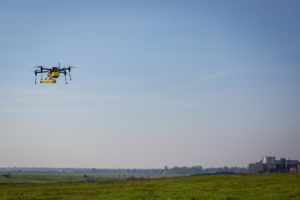
San Francisco-based Pacific Gas and Electric Company said they are testing drones to enhance the safety and reliability of their electric and gas service.
One of the largest combined natural gas and electric utilities in the United States, company officials said they are conducting two separate testing programs: one to explore the feasibility of using drones to monitor electric infrastructure in hard-to-reach areas and one to detect methane leaks across its 70,000-square-mile service area.
Test Flight Yields Early Safety Benefits
PG&E recently conducted its first drone test flight at the Balch Powerhouse, a hydroelectric facility located in the high Sierra Mountains outside Fresno.
Company officials said that current assessments of facilities like the Balch Powerhouse require employees to use fall-restraint equipment due to the height and the steep angle of the terrain as they visually inspect equipment, a hazardous task that requires significant investment in training and protective equipment to perform safely.
“These tests are helping PG&E demonstrate that drones can easily fly over remote or hard-to-reach terrain that is often inaccessible on foot, and send back imagery showing the condition of electric lines and equipment,” said Pat Hogan, senior vice president, Electric Transmission and Distribution, PG&E. “We see significant possibilities not just for employee and public safety, but for increasing reliability of our service and response time to outages.”
Ongoing Partnership with NASA
For the drone testing project, PG&E is working with NASA’s Jet Propulsion Laboratory (JPL), the University of California, Merced’s Mechatronics Embedded Systems and Automation Lab (MESA Lab), and Pipeline Research Council International to conduct testing of NASA’s Open Path Laser Spectrometer sensor on a drone.
The miniature methane sensor developed by JPL is similar to the technology developed to find life on Mars and is 1,000 times more sensitive than most commercially available technology, company officials said.
“The strategic investments we’re making in new technologies and innovative tools such as drones are part of our ongoing efforts to enhance safety and reliability of our utility infrastructure,” said Jesus Soto, senior vice president, Gas Operations, PG&E. “The ability to deploy an aerial methane detection tool over long distances and in remote areas could signal a major turning point in future gas leak detection capabilities for PG&E, and the larger utility industry as a whole.”
The first flight was performed at UC Merced on February 24, 2016. The next series of tests is scheduled to place in June.
All flights are being conducted within line of sight.
Future Benefits for Customers
While PG&E’s safety drone program is still undergoing testing, company officials said they are encouraged by its potential benefits.
“We will continue to explore the benefits of adding safety drones to our set of tools for inspecting utility infrastructure,” Hogan said.
PG&E also envisions drones playing a key role in storm and disaster response. Obstacles such as downed trees or icy roads make it difficult for crews to assess damage, which in turn hinders response and restoration time.
Using drones to capture high-resolution imagery in real time will help speed up damage assessments and the deployment of the right resources to restore power, Hogan added.
Alan is serial entrepreneur, active angel investor, and a drone enthusiast. He co-founded DRONELIFE.com to address the emerging commercial market for drones and drone technology. Prior to DRONELIFE.com, Alan co-founded Where.com, ThinkingScreen Media, and Nurse.com. Recently, Alan has co-founded Crowditz.com, a leader in Equity Crowdfunding Data, Analytics, and Insights. Alan can be reached at alan(at)dronelife.com